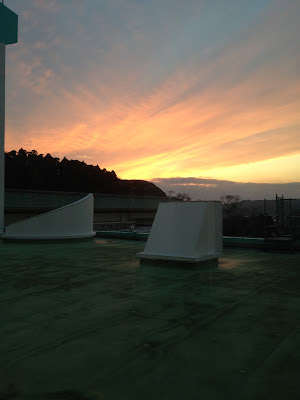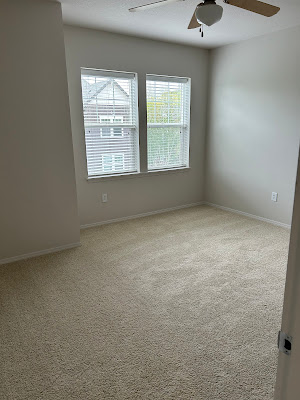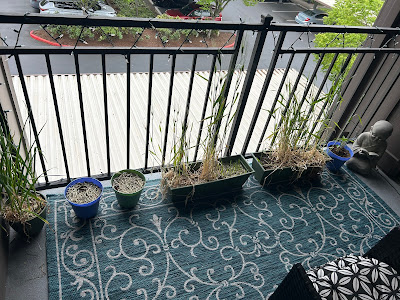While we always train too early in Japan to see cherry blossoms (sakura), plum (ume) have usually made their appearance in Tokyo
Wednesday, April 30, 2025
2025 Japan: Sublime And Amusing
Tuesday, April 29, 2025
2025 Japan: Ending And Beginnings
During our most recent training trip to Japan near the end of our time, our Headmaster made an announcement: He was thinking of not going back to where we had done our training for many years and training only in the Tokyo region.
Monday, April 28, 2025
A Year Of Living Apartmentally
Yesterday represented a year of living Apartmentally in New Home 3.0.
(All pictures from the past twelve months)
Sunday, April 27, 2025
A Year Of Humility (XVI): Accepting Salvation
One of the most humbling things anyone can do is accept the fact that they are a sinner, to agree with God's word that they are lost without His saving grace.
One of the next most humbling things is to believe it.
There seem to be two sorts of people in the world, those that have no problem believing it and those that have a great deal of trouble believing it. Perhaps unsurprisingly, I fall into the second bracket.
It is not, I suppose, that I question that He cannot do it. It is that I question that I can accept that it is done.
Arguably it comes from a lifetime of doubting myself, of second guessing my second guesses, of never willing to commit to a decision (and therefore, not believing anyone else can either).
I was reminded of my struggle that I have with this - and the certainty that I should have - by a song that was new to me at Easter (Run time 4:55).
Death was Arrested (North Point Worship)
Saturday, April 26, 2025
What Defines Us?
Friday, April 25, 2025
Essentialism (XV): Essence Of The Essentialist: Explore: Sleep
"The best asset we have for making a contribution to the world is ourselves." - Greg McKeown
McKeown starts the chapter with a story about a man named "Geoff".
At 36 he was at the pinnacle of his career: he was an Ernst and Young Entrepreneur of the year, a Young Global Leader, cofounder of a successful economic fund, and CEO of a global microlending organization that reached 12 million poor families. His schedule, as a result of this, was hectic: he traveled 60 to 70% of the year and slept 4 to 6 hours of sleep a night.
Which came at a cost, which manifested itself over time: night-time anxiety attacks with no anxiety, organs shutting down, physical impediments like being unable to stand up. After a series of emergency room visits and doctor visits, he was given two choices: be on medication for the rest of his life or take a year off and disconnect completely.
He chose the second option, swearing that he would only be away for a couple of months. What happened instead was unexpected, at least for him: 14 hours of sleep a night, six weeks of being unable to function. The two months became much, much longer.
Almost 2.5 years after the initial diagnosis, he was asked what his experience had taught him. "Protect the Asset" was his response - the asset, of course, being himself.
---
If we are the greatest asset we can contribute to the world, says McKeown, by underinvesting in ourselves - our minds, our bodies, our spirits - and failing to care for them means we are damaging that which we would use to make the highest contribution. And sleep, he, proposes, is one of those things.
Like "Geoff" above, McKeown experimented with his own reduced sleep schedule, trying to minimize it or even pulling once a week all-nighters. His results, perhaps unsurprisingly, were similar to the ones listed above. He may have gotten more "done", but it was not very well done.
Non-esssentialists, suggests McKeown, see sleep as just another thing to be done in an "already overextended, overcommitted, busy-but-not-always-productive life". Essentialists contrarily see it as necessary to operate at high levels of contribution, and thus systematically and with deliberation program sleep into their lives - yet another of the tradeoffs Essentialists acknowledge must be made.
---
The rest of this section is McKeown quoting various studies about the benefits of sleep. One that I found particularly interesting is a study by K. Anders Ericsson of violinists. The first factor - quoted in Malcom Gladwell's concept of "the 10,000 hour rule" - is that the best violinists spend more time practicing than the merely good violinists. No surprise there. But the next finding, not nearly as well known, was that the second most important factor differentiating the best violinists was...sleep. They average 8.6 hours a night, 1 hour more than average Americans at the time. Additionally, they spent 2.8 hours napping throughout the week. The authors of the study concluded not just that while the practiced more, the fact that they were well rested meant they could practice with greater concentration and thus get more out of the hours they practiced.
McKeown notes some companies at the time of writing were actively addressing this, by allowing variable hours (to accommodate early risers and night owls) or the infamous "nap pods" of Google or even setting policy that employees need not show up early (or at all) after a "red-eye" flight. Why? Because, he argues, those companies made the connection between well rested employees and excellent, creative work.
---
Application:
Sleep is something that has come up quite a bit for me this year.
I am famously a Non-essentialist in this regard: I for years have tried to program my life into allowing me the least amount of sleep that I need to allow me to "do" everything that I wanted or felt I needed to do. The result was completely unsatisfactory on almost every count: I was tired for the bulk of my career and everything I did was often in a haze of activity.
My thinking on this changed a great deal after reading the book Why We Sleep by Dr. Matthew Walker (which I recommend with the caveat that although Dr. Walker is as captivating a writer as an academic can be, there is a lot of material around the nature of sleep and how we came to know that and his opinions on policies about sleep to get to the part about actual sleep recommendations. If you can find the Appendix online, that is the application). Beyond just all of the physiological benefits of sleep - which may include helping guard against Alzheimer's, something I am pretty interested in - he makes the very strong recommendation that everyone beyond the age of a teenager (e.g., when we hit our adult sleep patterns) needs 8 hours of sleep a night (or even little more). But not really less than 7 hours.
8 hours of uninterrupted sleep is almost unheard of for me; my sleep pattern seems destroyed after the birth of Nighean Gheal and has never really come back (a casualty of being a parent); at most, I can generally sleep about 6 hours without waking and if I am lucky after that waking, slip in another hour of dozing. What that means is that more like 7 hours a night.
That said, I try to act as if I am going to get eight hours a night.
Two things that Walker recommends are 1) Have a standard going to bed time including wind down that you never vary from; and 2) Have a standard waking up time you never vary from. This has been the greatest challenge for me - not the standard waking up time, but rather the standard going to bed time. Why? Because of course I am trying to fit "one more thing" into my day.
The other thing that I am practicing is that unless it is my waking up time (or within 15 minutes), I stay in bed. I am not getting into the habit of waking up and deciding to get up and do things. My father did that, until he was waking up at 0300 every morning. I may not be able to go back to sleep, but I will not cave in to the fact that like or not, 8 hours is the goal.
Do I really hit that goal? No. I am still somewhat trying to fine tune my sleep pattern between when I wake up and when I go to sleep. A full 8 hours would have me preparing for bed at 2030 and going to bed at 2100 - but I wake up far before 0500 and do not always go back to sleep. And so I am working on fine tuning that time - somewhere between 2100 and 2145 seems ideal; 2200 is too late. And based on those times, 7 to 7.5 hours is the maximum I seem to be able to get a night.
Do I feel better? Somewhat surprisingly, I do. I still struggle with not "getting enough done". But I can now very definitively tell when I have enough sleep - and when I have not.
Thursday, April 24, 2025
The Collapse CLXXXIX: Strongholds
02 November 20XX+1
My Dear Lucilius:
Between my missive of two nights ago and today, Old Man Winter has made his arrival with a vengeance: a full foot of snow has fallen. It certainly makes me glad I did my walking last week and did not wait until now.
Snow – really any inclement weather – has an odd magic about it even in such a situation as we find ourselves now. In earlier days it would have been an inconvenience, a thing to be managed and planned around. Now it effectively shuts everything down with a soft sort of thud. The snow will melt of course, and then come back and then melt again, until we see the other side of it in March or April.
If there is any blessing in this, it is that what shuts us down shuts almost everything and everyone else down as well. While it is not certain that we will not have “visitors”, the chances are greatly reduced.
Especially if they were walking when this hit.
---
I left you with a bit of a puzzle in the last letter. I laid out for you the geographic location and situation of our town, its likeliest threats, and the puzzle of what to do given a town split in half by a road (and by sentiment) with the most likely risks coming from two particular directions in what could be quick attacks (or any direction in longer directions, of course).
I had originally thought of the school building this town still has from the early 20th Century. It is brick (which is a plus) and is somewhat away from everything else on flat land, thus giving a clear field of fire. Unfortunately it suffers from one defect: it is a bit far.
The school sits about ¼ of a mile away from the center of town – a little farther for some (like myself), a little less for those closer. The idea of getting everyone there in short order, let alone with the essentials, is a bit daunting – and in the direction of at least one of the threats that could come quickly. Yes, I suppose we could “store” things there, but that also creates a second problem of security , a problem I am not ready to deal with at the current moment.
Given that – which still have potential – I was forced to cast about for second options. Oddly enough, one was right in front of my face: The Post Office.
The Post Office (which shares a building with the once-upon-a-time gas station and mini-mart) is literally in the center of town. The “bad” news is that it is literally right next to the highway that runs through town. The “better” news is that it is made of masonry blocks, has a pretty clear field of fire, and is literally in the center of town – at worst a one minute transit for anyone.
We have used it before for various things as you may recall, so I believe we could reasonably get the current engaged population inside (perhaps not long term comfortably, but reasonably). It has limited points of access in terms of doors and windows which could be fairly easily barricaded – or so Young Xerxes and his nascent band of stalwarts assure me; I am not military engineer. The roof is obviously not stone of course, so that presents a bit of a fire hazard, although I suppose that tin roofing (could we ever find any) could be overlaid.
The problem, as I am defining it, is what would be the most likely occurrence. If history is any guide at all in similar situations (as if economic collapse was all that “similar”), attackers come in two types: raiders and settlers. The settlers are the far more pernicious (Ask the Britons how the Angles, Saxons, and Jutes worked out for them) but do not strike me as the most likely. It is from groups that are similar to what came through in July that we need worry about more: the raiding bands that seek only to loot and move on.
Could both locations work? I do not know that there is not a place for a short term and long term solution. And surely I do not have all the answers; all I have is a need and trying to find the best way to fill it.
The immediate need, of course is the short term one. Another benefit? Much of the current work could done inside, a plus given the weather that has just arrived.
Sometimes even that which seems to shut us down can be used to our advantage.
Your Obedient Servant, Seneca
Wednesday, April 23, 2025
2025 Japan: Sengakuji (II)
On the morning of 31 January 1703 (Western Calendar), the end of a drama started 14 months before played out (Author's Note: This is largely pulled from last year's post).
The Ako Icident (as it is formerly referred to in the history of the time) started in 1701, when a daimyo, Asano Naganori, was forced to commit seppuku (ritual suicide, literally "cutting of the stomach") after he attacked a high court official, Kira Yoshinaka, in the palace of the Shogun. To draw a sword inside the castle was strictly forbidden, to attack even more so. Asano had felt deeply insulted as Kira has degraded and insulted him in the course of instructing him in court etiquette (popular rumor was it was because Kira was hoping for a bribe).
The Ronin had always planned this as a possible outcome. And so, on 20 March 1703, the 46 committed seppuku. Their remains, along with the remains of Lord Asano and his wife Yozen-in (Buddhist name), were buried at Sengaku-ji.
Further information: If one wants to learn more, the Wikipedia link above is a great start. Do not - and I mean DO NOT (Update 2025: By all means DO NOT) - by any means watch the more recent movie starring Keanu Reeves (whom otherwise I enjoy as an actor) - it has almost nothing to do with the actual story except there may be a revenge and 47 Ronin may be involved. If you have a long period of time, there was a 1941 movie produced which, while not having the fighting, is probably more true to the actual events (located at archive.org). There have been more recent (1950's to 1970's) adaptations. Perhaps unsurprisingly, it instantly became a classic in the samurai culture and remains so to this day.
For written works, I cannot recommend highly enough Donald Keene's translation of Kandehon Chushingura (more colloquially known as "The Chushingura)". Originally developed as a bunraku (puppet play), it had to recast the events to an earlier period due to Shogunal censorship but retains the spirit of the events (especially Oishi's deception).
 |
| The 47 Roinin (Source) |


















































